Map Construction: Two-Party Hare Quota Maps
Two-party (S = 2) two-winner (W = 2) scenario: Two parties A and B compete in a Hare Quota Party-List election to fill two vacant seats. Let the proportion of voters V preferring A to B be x and those preferring B to A be y; where x + y = 1. Each party nominates a closed list of its own candidates from 1 to W; where here W = 2. The Hare Quota is defined as V/W but the maps use tally shares (t) rather than absolute tallies (T). Hence, for tally shares (where t = T/V), the Hare Quota becomes 1/W and in this scenario it equals 1/2.
All the votes for a particular party initially go to the leading candidate on the party list. Any votes in excess of the quota are then transferred to the second candidate on the list. Every candidate achieving the quota is elected and, if a seat then remains to be filled, the candidate with the highest remaining tally share also wins. Where two candidates tie for this vacancy, this critical tie must be resolved by the random selection of one of them as the winner. Such critical ties define the seat share domain boundaries on the two-party map.
The standard election profile notation and formats are used below to state the tally and tally share for each party.
- TA = xV and tA = x for the election profile x: A1,A2.
- TB = yV and tB = y for the election profile y: B1,B2.
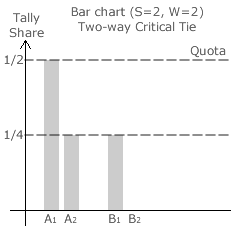
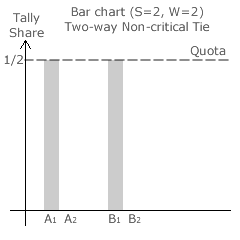
As the Hare Quota is a largest remainder method, bar charts can be used to display the distribution of the votes between all the candidates after the final round of counting. These bar charts are useful in determining the critical and non-critical ties for the specific election that are needed for the two-party map. Two examples are shown opposite.
The non-critical tie results when the two parties have an equal vote share (so x = y = 1/2) and the two seats are awarded to the prime candidate in each of the two parties. This tie represents a truly proportional outcome since both the tally share ratio and the seat share ratio are 1:1.
A critical tie occurs when the support for party A is triple that for party B; where x = 3y (so x = 3/4 and y = 1/4). Note that having exceeded the quota with t = x = 3/4, A1 is the outright winner of the first vacancy. However, since A2 and B1 are tied on the same 1/4 tally share, the second seat goes to either A2 or B1 selected at random. With zero tally share, B2 is the clear loser here.

If support for party A was to increase (x > 3/4) then both A candidates would be elected. Similarly, if support for party B exceeded three times that for party A, then both B candidates would win. Otherwise, when each party receives between one quarter and three quarters of the vote, then each party wins one seat. These three different seat share domains are shown on the two-party two-winner map opposite. The two critical ties (at x = 1/4 and x = 3/4) define the two boundaries between these three domains.
Two-party (S = 2) three-winner (W = 3) scenario: Two parties A and B compete in a Hare Quota Party-List election to fill three vacant seats. Let the proportion of voters V preferring A to B be x and those preferring B to A be y; where x + y = 1. Each party nominates a closed list of its own candidates from 1 to W; where here W = 3. The standard election profile notation and formats are used below to state the tally and tally share for each party.
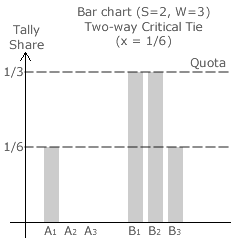
- TA = xV and tA = x for the election profile x: A1,A2,A3.
- TB = yV and tA = y for the election profile y: B1,B2,B3.
For this scenario, the quota of 1/W is 1/3. With three winners, there are four seat share domains; namely, 0:3, 1:2, 2:1 and 3:0. Hence, there are three and only three critical tie boundaries that separate them. These three two-way critical ties are shown in the adjacent bar charts. In each case, notice that the two critically tied candidates each have a tally share that is half of the quota. The other candidates either have a full quota or a zero share.
The first critical tie occurs at x = 1/6. Here, B1 and B2 take the first two seats outright with either B3 or A1 winning the third seat on a random tie break.
The second critical tie occurs at x = 1/2. Now, A1 and B1 automatically get a seat each while A2 and B2 enter the random tie breaker.
The third and only other critical tie occurs at x = 5/6. Here, A1 and A2 take the first two seats outright with either A3 or B1 winning the third seat at random.
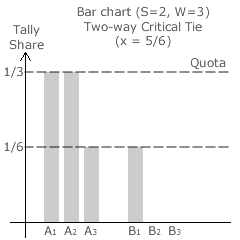
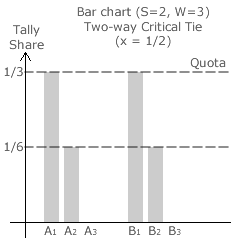
Notice that the values of x for the three critical two-way ties are odd-number multiples of half of the quota (t = 1/6) within the range 0 < x < 1; namely 1/6, 3/6 and 5/6. The same can also be seen in the previous scenario as x is 1/4 and 3/4 where 1/4 is half of the quota.
The critical ties occur when the remaining tally shares (that necessarily sum to one full quota share) are split equally between the two parties. In other words, the two critically tied candidates inevitably have half of the quota each. It is no co-incidence that only odd integer multiples of the quota generate critical ties.
Even-number multiples of half of the quota is the same as integer multiples of a full quota. Here, each of the W candidates achieving a full quota of 1/W is elected. There is no remainder and all the other candidates have a zero tally share. These are the non-critically tied situations. As an example, see the bar chart for the two-way non-critical tie in the two-party (S = 2) two-winner (W = 2) election example above.
Two-party (S = 2) multiple-winner (W = W) scenario: Two parties A and B compete in a Hare Quota Party-List election to fill W vacant seats. Let the proportion of voters V preferring A to B be x and those preferring B to A be y; where x + y = 1. Each party nominates a closed list of its own candidates from 1 to W. The standard election profile notation and formats are used below to state the tally and tally share for each party.
- TA = xV and tA = x for the election profile x: A1,A2,~~~~,AW.
- TB = yV and tA = y for the election profile y: B1,B2,~~~~,BW.
For this scenario, the quota is 1/W. With W winners, there are 1+W seat share domains. Hence, there are only W boundaries that separate them. Here again, the values of x for the W two-way critical ties that define the domain boundaries are inevitably odd-integer multiples of half of the quota (t = 1/2W) within the range 0 < x < 1. The table below lists these domain boundary values of x for two-party scenarios with up to six winners.
| Number of Winners (W) | Quota | Domain Boundary Values of x |
|---|---|---|
| 1 | 1/1 | 1/2 |
| 2 | 1/2 | 1/4, 3/4 |
| 3 | 1/3 | 1/6, 3/6, 5/6 |
| 4 | 1/4 | 1/8, 3/8, 5/8, 7/8 |
| 5 | 1/5 | 1/10, 3/10, 5/10, 7/10, 9/10 |
| 6 | 1/6 | 1/12, 3/12, 5/12, 7/12, 9/12, 11/12 |
The two candidates (one from each party) that are competing for the final vacant seat have tally shares that sum to one full quota. They tie when they each have a half-quota. When one candidate has over one half, this candidate is elected. The other candidate has under one half and loses. The candidate with the larger remainder wins.
For an optimally proportional voting (OPV) system in a two-party election, the number of seats awarded to the two parties in proportion to their tally shares is rounded (up or down) to the nearest integer. For the last vacancy in the Hare Quota Party-List method, the larger remainder is effectively rounded up to a full quota (as that candidate wins) and the smaller one is essentially rounded down to a zero quota (as this candidate loses).
In other words, for two-party multiple-winner elections, the Hare Quota Party-List method is identical in outcome to that of an OPV system. The two-party Hare Quota maps are therefore already constructed and are shown within the corresponding two-party CHPV maps; see the two-party OPV maps on the Evaluations: CHPV Maps 1 page.
Return to main text > Comparisons: Party-List ~ Hare Quota
Refer to > Map Construction: Table of Contents
